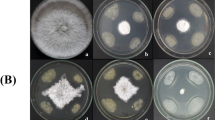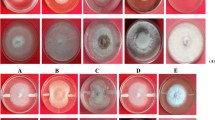Abstract
Rice (Oryza sativa) is a staple food in Thailand and, in addition, feeds around one half of the world’s population. Therefore, diseases of rice are of special concern. Rice is destroyed by 2 main pathogens, Fusarium oxysporum and Pyricularia oryzae the causative agents of root rot and blast in rice respectively. These pathogens result in low grain yield in Thailand and other Southeast Asian countries. Soil samples were taken from paddy fields in Northern Thailand and bacteria were isolated using the soil dilution plate method on Nutrient agar. Isolation yielded 216 bacterial isolates which were subsequently tested for their siderophore production and effectiveness in inhibiting mycelial growth in vitro of the rice pathogenic fungi; Alternaria sp., Fusarium oxysporum, Pyricularia oryzae and Sclerotium sp., the causal agent of leaf spot, root rot, blast and stem rot in rice. It was found that 23% of the bacteria isolated produced siderophore on solid plating medium and liquid medium, In dual culture technique, the siderophore producing rhizobacteria showed a strong antagonistic effect against the Alternaria (35.4%), Fusarium oxysporum (37.5%), Pyricularia oryzae (31.2%) and Sclerotium sp. (10.4%) strains tested. Streptomyces sp. strain A 130 and Pseudomonas sp. strain MW 2.6 in particular showed a significant higher antagonistic effect against Alternaria sp. while Ochrobactrum anthropi D 5.2 exhibited a good antagonistic effect against F. oxysporum. Bacillus firmus D 4.1 inhibited P. oryzae and Kocuria rhizophila 4(2.1.1) strongly inhibited Sclerotium sp. P. aureofaciens AR 1 was the best siderophore producer overall and secreted hydroxamate type siderophore. This strain exhibits an in vitro antagonistic effect against Alternaria sp., F. oxysporum and P. oryzae. Siderophore production in this isolate was maximal after 15 days and at an optimal temperature of 30°C, yielding 99.96 ± 0.46 μg ml−1 of siderophore. The most effective isolates were identified by biochemical tests and molecular techniques as members of the Genus Bacillus, Pseudomonas and Kocuria including B. firmus D 4.1, P. aureofaciens AR1 and Kocuria rhizophila 4(2.1.1). The study demonstrated antagonistic activity towards the target pathogens discussed and are thus potential agents for biocontrol of soil borne diseases of rice in Thailand and other countries.

Similar content being viewed by others
Abbreviations
- CAS:
-
Chrome Azurole S
- c.f.u:
-
Colony Forming Unit
- nm:
-
Nanometre
- OD:
-
Optical Density
- SD:
-
Standard deviation
References
Alabouvette C, Lemanceau P, Steinberg C (1993) Recent advances in the biological control of fusarium wilts. Pestic Sci 37:365–373. doi:10.1002/ps.2780370409
Arnow LE (1937) Colorimetric determination of the components of 3, 4-dihydroxyphenylalanine-tyrosine mixtures. J Biol Chem 118:531–537
Asghar HN, Zahir ZA, Ashad M (2004) Screening rhizobacteria for improving the growth yield and oil content of canola (Brassica napus L.). Aust J Agric Res 55:187–194. doi:10.1071/AR03112
Chandra S, Choure K, Dubey RC, Maheskwari DK (2004) Rhizosphere competent Mesorhizobium loti MP 6 induces root hair curling, inhibits Sclerotinia sclerotiorum and enhances growth of Indian mustard (Brassica campestris). Braz J Microbiol 24:35–39
Dean RA, Talbot NJ, Ebbole DJ, Farman ML, Mitchell TK, Orbach MJ, Thon M, Birren BW (2005) The genome sequence of the rice blast fungus Magnaporthe grisea. Nature 434:980–986. doi:10.1038/nature03449
Dowling DN, O’Gara F (1994) Metabolites of Pseudomonas involved in biocontrol of plant diseases. Trends Biotechnol 12:133–141. doi:10.1016/0167-7799(94)90091-4
Elizabeth ABE, Handelsman J (1999) Biocontrol of plant diseases: a (Gram) positive perspective. Febs Microbiol Lett 171:1–9. doi:10.1111/j.1574-6968.1999.tb13405.x
Gupta CP, Dubey RC, Maheshwari DK (2001) Antibiosis-mediated necrotrophic effect of Pseudomonas GRC2 against two fungal plant pathogens. Curr Sci 81:90–94
Gupta CP, Dubey RC, Maheshwari DK (2002) Plant growth enhancement and suppression Macrophomina phaseolina causing charcoal rot of peanut by fluorescent Pseudomonas. Biol Fertil Soils 35:399–405. doi:10.1007/s00374-002-0486-0
Handelsman J, Stabb EV (1996) Biocontrol of soilborne plant pathogents. Plant Cell 8:1855–1869
Hass D, Defago G (2005) Biological control of soil born pathogens by fluorescent pseudomonads. Nat Rev Microbiol 3:307–319. doi:10.1038/nrmicro1129
Haydon AH, Davis WB, Arceneaux JEL, Byers BR (1973) Hydroxamate recognition during iron transport from hydroxamate iron chelates. J Bacteriol 115:912–918
Holt JG, Krieng NR, Sneath PHA, Staley JT, Williams ST (1994) In: Bergey’s manual of determinative bacteriology, ninth ed. Williams and Wilkins Pub
Landa BB, Hervas A, Bethiol W, Jimenez-Diaz RM (1997) Antagonistic activity of bacteria from the chickpea rhizosphere against Fusarium oxysporum f.sp. ciceris. Phytoparasitica 25:305–318. doi:10.1007/BF02981094
Lim HS, Lee JM, Kim SD (1999) Role of siderophore in biological control of Fusarium solani by Pseudomonas fluorescens GL 20. Bull Inst Agric Sci Kimki Unive 7:47–58
Milagres AMF, Machuca A, Napaleao D (1999) Detection of siderophore production from several fungi and bacteria by a modification of chrome azurol S (CAS) agar plate assay. J Microbiol Methods 37:1–6. doi:10.1016/S0167-7012(99)00028-7
Milner JL, Stohl EA, Handelsman J (1996a) Zwittermicin a resistance gene from Bacillus cereus. J Bacteriol 178:4266–4272
Milner JL, Silo-Suh LA, Lee JC, He H, Clardy J, Handelsman J (1996b) Production of Kanosamine by Bacillus cereus UW85. Appl Environ Microbiol 60:2553–2560
Montealegre JR, Reyes JR, Perez LM, Herrera R, Silva P, Besoain X (2003) Selection of bio-antagonistic bacteria to be used in biological control of Rhizoctonia solani in tomato. Electron J Biotechnol 6:115–127
Neilands JB (1999) Siderophore: structure and function of microbial iron transport compounds. J Biol Chem 270:26723–26726
Payne SM (1994) Detection, isolation and characterization of siderophores. Methods Enzymol 235:329–344. doi:10.1016/0076-6879(94)35151-1
Peabody E (2004) New Explored Rice Gene Could Help Blast Killer Fungus-August 12:2004. -News from the USDA Agricultural Research Service
Perez-Miranda S, Cabirol N, George-Tellez R, Zamudio-Rivera LS, Fernandez FJ (2007) O-CAS, a fast and universal method for siderophore detection. J Microbiol Methods 70:127–131. doi:10.1016/j.mimet.2007.03.023
Pidiyar VJ, Jangid K, Patole MS, Shouche YS (2004) Studies on cultured and uncultured microbiota of wild Culex quinquefasciatus mosquito midgut based on 16S ribosomal RNA gene analysis. Am J Trop Med Hyg 70:597–603
Rao CVS, Sachan IP, Johri BN (1999) Influence of fluorescent pseudomonads on growth and nodulation of lentil (Lensesculentus) in Fusarium-infested soil. Indian J Microbiol 39:23–29
Ruaska L, Mattila-Sandholm T (1995) Effect of iron level on the antagonistic action of siderophores from non-pathogenic Staphylococcus spp. J Ind Microbiol 15:480–485
Schwyn B, Neilands B (1987) Universal chemical assay for the detection and determination of siderophores. Anal Biochem 160:46–56
Skidmore AM, Dickinson CH (1976) Colony interaction and hyphal interference between Sartoria nodorum and phylloplane fungi. Trans Brit Mycol Soc 3:57–64
Sokal RP, Rohlf JF (1995) Biometry: the principles and practice of statistics in biological research, 3rd edn. WH Freeman & Co., New York
Williams GE, Asher MJC (1996) Selection of rhizobacteria for the control of Pythium ultimum and Aphanomyces cochlioides on sugar-beet seedlings. Crop Prot 15:479–486
Acknowledgments
This work was supported by a grant from the Commission on Higher Education. Ministry of Education, Thailand and grants from the Graduate School of Chiang Mai University, Chiang Mai, Thailand.
Author information
Authors and Affiliations
Corresponding author
Rights and permissions
About this article
Cite this article
Chaiharn, M., Chunhaleuchanon, S. & Lumyong, S. Screening siderophore producing bacteria as potential biological control agent for fungal rice pathogens in Thailand. World J Microbiol Biotechnol 25, 1919–1928 (2009). https://doi.org/10.1007/s11274-009-0090-7
Received:
Accepted:
Published:
Issue Date:
DOI: https://doi.org/10.1007/s11274-009-0090-7




